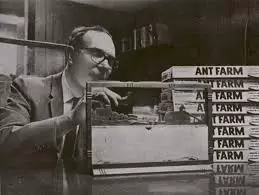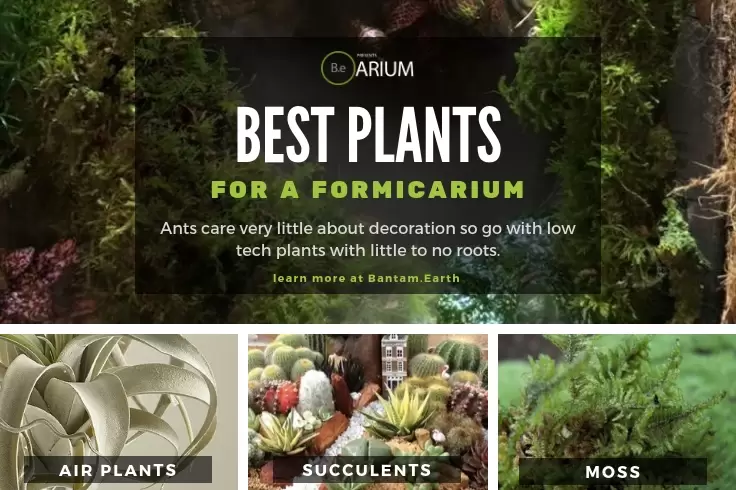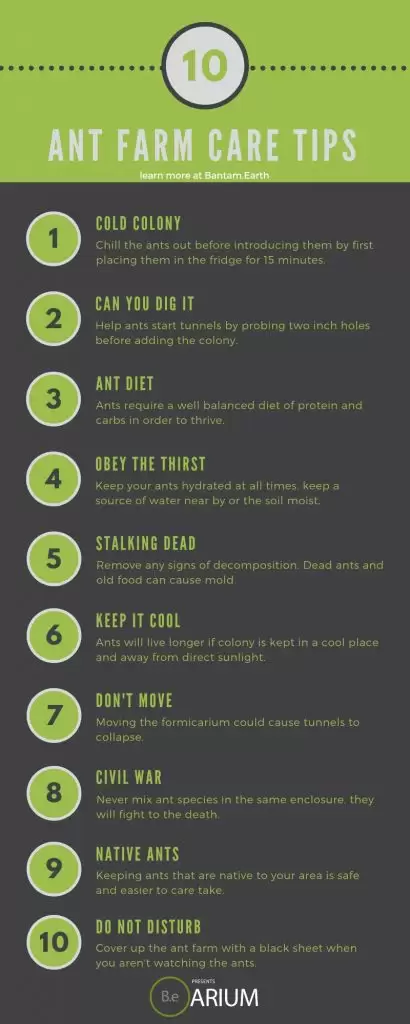Ant farms are, by far one of the most popular vivariums in the hobby. Many might not see a formicarium the same way they see an aquarium or terrarium… But those of us that are here for the sheer beauty of the ant empire, will appreciate this detailed guide to housing ant colonies!
Table Of Contents:
ToggleWhat Is A Formicarium?
A formicarium, also commonly referred to as an “ant farm”, is a type of vivarium that consists of ant colonies. The formic part of the word comes from the Latin word Formica, meaning “ant.” The word itself translates to “a place of ants.” The plural form of formicarium is formicaria.


The History Of Ant Farms
The very first ant farm was created by a French engineer named Charles Janet in the early 1900s. He wanted to make the traditional ant colony more visible for observation.
His pioneering design of the 2D ant nest was the birth of many later patented concepts we recognize today. Charles had no intentions of marketing the vivarium and was reluctant to have it featured in Paris at a world fair called Exposition Universelle 1900.


An Inventor by the name of Frank Austin was the first to commercially sell ant farms and obtained many patents for his recreated design starting in 1929. Many of Frank’s formicaria consisted of above-ground landscapes like miniature farms, castles, and forests for added aesthetics.


The actual term “Ant Farm” was registered in 1956 by Milton Levine, the founder of Uncle Milton Industries. Milton’s supposed design was unlike Frank’s ant vivarium and claimed it to be more of an entertainment model rather than an educational device, unlike Levine’s version.
The term Ant Farm gained a bit of infamy back in 95′ when Uncle Milton’s lawyers decided to make threats to comic book author Scott Adam for the unauthorized use of the term in a Dilbert comic strip.
How To Build An Ant Farm
Building a formicarium is a fun project for all ages. Once you get an understanding of the key features, you can build an ant farm out of almost anything. This section of the guide will cover the basic build of an ant vivarium.
Setting Up The Nest
The substrate layer is the heart of the formicarium. All ant farms will consist of this layer no matter what type of setup you build. This zone will usually consist of some type of soil, sand, or even gel. The bulk of the ant colony, as well as the queen, will reside here. The nest area should be quite dark when not observed to influence a healthy and thriving colony.
Scaping The Ground Cover
The Landscape layer is the above-ground surface space used for finding food and waste disposal. This part of the vivarium will be the area ants will scavenge for resources. Drop food for your ants to distribute among the colony here.
You may also find that ants will store unwanted items like their excessive waste, their dead, and loose dirt here as far away from their colony as possible. If a hardscape is going to be applied, it will go here as well.
This can either be various types of wood or stone depending on preference. I go further into detail about hardscapes in this article here if you need help deciding which material would be appropriate for your ant farm.
Containing The Colony
The Containment layer is like the ozone level of this miniature ecosystem. This zone is a critical part of the enclosure and keeps our ants from escaping the formicarium. The traditional way of doing this would be to use nontoxic deterrents like petroleum jelly, talcum powder, or PTFE.
Putting It Together
Setting up an ant farm is a straightforward process that doesn’t require a lot of materials. Depending on the specific type of formicarium you desire to build, it will either be a simple two-step container with soil… Or a complex paludarium with filtration. The next section will cover a few examples of ant vivariums you can build for any number of ant colonies.


Different Types Of Formicaria
Have you ever heard the expression “There is more than one way to house an ant?” Probably not… But the statement still applies! Think about the reasons for starting a formicarium before deciding on the type of setup to go for.
Terrarium Style Ant Farm
A terrarium-style ant farm is designed in a more traditional sense of a vivarium. You would fill a container with the substrate and add foliage or decoration. Any type of enclosure normally used to house animals would be adequate. These types of formicaria are very aesthetically pleasing and offer ants
Even though the nesting layer won’t be as revealing for observational purposes, the dark unveiled spots will provide security and influence less stress on your ant colony. They will appreciate the privacy and thrive as a community. This type of formicarium is ideal if you want to house a queen.
Sandwich Style Ant Farm
A sandwich-style ant farm is a vertical type of formicarium made in a two-dimensional format. These designs are made for easy observation of the ant colony. You could either buy an already assembled ant farm kit or DIY with 2 panels of glass or plastic and some type of substrate.
This type of vivarium is more commonly used for studying or entertainment. A nice advantage you have with a sandwich-style ant farm, you could go substrate-less and set up layers in a maze format for your ants to maneuver through.
Unfortunately, this setup would not be fit for a queen due to the lack of seclusion needed to make her feel protected.


Best Types Of Substrate For Ant Farms
So there are a few options when it comes to the substrate for formicaria. When deciding on a specific substrate, keep in mind what is recommended for the intended ant species being kept as well as the type of ant farm enclosure being used to house the colony.
- Sand is probably the easiest to work with as well as making the ant army visible. If you form the tunnels yourself, make sure to wet the sand first. It will make the tunnels hold up better.
- Soil would be the most natural ant farm substrate option to go with. Ants will find additional nutrients from a modified soil mixture and adding additional foliage will benefit greatly from the mineral-rich soil used in the vivarium.
- Gel formulated for ant farms is another option that has become a popular type of substrate. Though, it does receive mixed opinions about its use in a formicarium. Ant farm gel is an artificial substrate made specifically for ants to develop a nest in. This type of substrate is also nutrient-rich and edible.. intentionally designed for ants to survive on.


Best Types Of Plants For Ant Farms
If you decide to go with a terrarium-style ant farm and would like to decorate the landscape with live plants, here are a few things to keep in mind before going out to get plants:
- Ants like moist substrates. Keep in mind that you will want to stick with plants that don’t mind consistently damp soil.
- Ants care very little about decoration. These guys will break down anything they can and use it as a building material for the nest. If you are OK with knowing there’s a possibility the ants will hollow out plants, uproot them or even relocate them all together then go with the plant of choice.
- Low-maintenance plants with little to no roots do best. Air plants and succulents would be my recommendation for a formicarium. These plants won’t need much water so you won’t have to worry about drowning ants. You don’t have to worry about uprooting or relocating harming these types of plants.


10 Care-Taking Tips For A Vigorous Formicarium
Taking care of an ant farm is relatively simple. This is why ant farms are ideal for young children starting in the vivarium hobby. Here are 10 tips that will guide any level ant keeper to maintaining a successful ant colony:
1. Chill The Colony Out Before Introducing Them.
A really clever trick to transferring ants in a controlled manner is to lower their body temperature before the institution. Putting them in the refrigerator for about 15 minutes will calm ants down and they will move a lot slower until warming back up.
2. Prepare The Nest Before Introducing A New Colony.
A simple, yet viable, task that will help jump-start a new batch of ants is to create tunnels. Ants might find their new environment confusing and stressful. Looking for an immediate place of shelter, pre-probed holes about two inches deep will be all that is needed for ants to find their place.
3. Feed Ants Proportionately And Accordingly.
It’s easy to notice ants in the wild will eat just about anything. But if we want a thriving colony, we will have to give our ants a well-balanced diet. Ants require protein and simple carbohydrates to survive. Fruits and any type of sugar are good sources of carbs.
Insects dead or alive are a good source of protein. Be careful not to overfeed your ants, wasted uneaten food will bring unwanted mold and bacteria to the enclosure.
4. Keep Your Ants Hydrated.
This is a very important necessity for ants along with a healthy diet. Keeping a small tray full of water at all times would be ideal but if the enclosure is too small for a tray, you could also use a dropper to keep the top layer of substrate moist.
5. Remove Any Signs Of Decomposition.
Ants are very neat and tidy animals. They do a really great job of keeping the nest clean. They bring all of their dead as well as uneaten food out to the landscape area. Remove this type of waste as needed to prevent mold build-up.
6. Keep The Enclosure In A Cool Area.
The real secret to the longevity of an ant colony is temperature. Remember in the earlier tip how cooling them down slowed their movement… Well, this also slows their metabolism and their actual life span too.
Finding an area in your house that’s about 70 to 75 degrees Fahrenheit will be perfect for the ant nest to thrive as a community. Keep it away from direct sunlight and don’t put it in an area too cold or the ants might slip into hibernation.
7. Don’t Move The Formicarium.
So this might not be obvious but once your ants start building tunnels, moving the ant farm could potentially cause tunnels to collapse. Find a good place to set the formicarium and leave it completely still to prevent unnecessary stress.
8. Don’t Mix Ant Species.
Most ants will not take well to foreign colonies. Ants will go to war with one another if you put two or more species together. So definitely don’t do that!
9. Keep An Ant Species Native To Your Environment.
There are a number of reasons to stick to colonies found locally within your particular area. For one, it’s illegal to bring some species of ants into some countries. If a particular ant species are invasive and break free, it could cause serious damage to the environment, causing other insects to go extinct.
Another good reason to go with native ants is they will be much easier to care for already being used to environmental elements like temperature and resources.
10. Cover The Ant Farm When Not Observing.
This is a bonus tip for those looking to make a sandwich-style formicarium. Ants like being in the dark. They feel safe and thrive when having a comfortable nest to retreat to. Using a black sheet or box to cover the ant farm when you aren’t studying them will lead to a more active and developed colony.


Best Ant Farm Kits
Formicarium kits are great for those looking for a complete set to kick-start their hobby. In most cases, an ant farm kit will come with everything needed to house your ant colony. If you are looking for ant farm kits you can buy with everything needed to get started on a project, here are a few editor’s picks we recommend taking a look at:
Giant Ant Farm Kits


The Giant Ant Farm Kit by Uncle Milton is a re-design of the ant farms originally sold by Uncle Milton back in the 1950s. This kit comes with sand as well as “antport” tubes for easy transferring of livestock. This 2-D kit is good for all ages and highly recommended for classrooms.
Gel Ant Farm Kits


Gel Ant Farm Kits take a unique twist on the traditional 2D formicarium. A transparent gel is used in the place of sand with these ant farms giving off a very interesting look to the vivarium. This particular design cleverly takes advantage of the clear substrate with the use of LEDs lighting up the entire formicarium.
Binary Ant Farm Kit


A Binary Ant Farm Kit is a formicarium that mimics a true anthill nest. This formicarium combines the 2D design with an open surface area ants can go hunt for resources and deposit waste. This type of setup would be the most ideal if you are considering the idea of having a queen in your colony.
Vivariums Similar To A Formicarium
The many other types of vivariums you will see out there are more than likely based on one of these core designs. If you are building a vivarium with the intention of housing a specific type of plant or animal, be sure to go with a design that closely fits their needs. If you enjoyed this type of content, be sure to check out some of the other popular types of enclosures we’ve covered in the past:
Conclusion
I would highly recommend ant keeping to anyone looking to start out in the formicarium hobby. It’s a really good opportunity to teach young children the cycle of life as well as responsibility and it’s a fun opportunity for adults to learn more about nature. For any enthusiast out there already familiar with ant keeping, what types of species do you have and where are you located?


Frequently Asked Questions
A formicarium is a small ant colony habitat designed for observing ant behavior and studying ant behavior. It can also be used to keep ant colonies in a controlled environment so that researchers can study the behavior of the ants more effectively.
Ants! Formicariums are habitats specially designed for housing pet ants. They can come in different sizes, configurations, and materials. They typically feature special air vents, water reservoirs, and other environment–friendly features that encourage the ants to thrive.
To keep ants out of your formicarium, make sure to:
- Seal any cracks or holes in the formicarium.
- Regularly check for signs of ant activity inside and outside the formicarium.
- Place an ant-repellent powder, spray, or liquid near potential entry points.
- Place Vaseline or other sticky substance around the rim of the formicarium’s lid.
- Placing the formicarium in a greenhouse or another enclosed space will create a barrier that ants can’t cross.
A formicary is a type of ant nest, specifically an ant nest built underground. The name is derived from the Latin word formica, which means “ant”. Formicaries serve as a housing structure for ants and provide protection from predators and harsh weather.
People buy ant farms because they provide a dynamic and educational experience. They can be used to watch and learn about the behavior of various species of ants, as well as teach kids about the natural world and how animals interact with each other and their environment. Ant farms can also be used as an intriguing decoration for the home, as well as a fun and affordable hobby.
Yes, an ant farm can survive without a queen. Worker ants are able to reproduce asexually and will create new female workers to replace the queen. Without a queen ant, colonies may become unstable as males compete for dominance.
An ant farm can survive for up to 5–6 years with proper care and maintenance. To extend the life of an ant farm, be sure to provide a regular supply of food and water, maintain a consistent room temperature, and change the substrate every year to ensure the ants have a clean environment.



